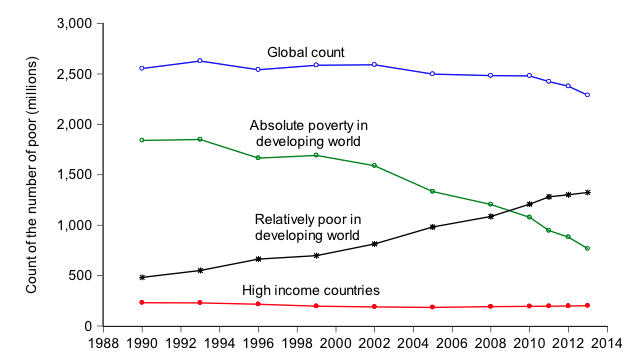
A new poverty measure reveals that in the past 25 years, global poverty has declined but relative poverty has increased in developing countries
Past studies have measured poverty in either relative terms (mostly in the developed countries) or absolute terms (the developing world). A new unified approach to global poverty assumes that people care about both their own income and their income relative to others in their country of residence. Accordingly, global poverty has declined more in absolute terms than in relative terms, with the bulk of the relatively poor living in the developing world. Compellingly, developed countries have seen little progress against poverty, unlike the developing world.
Measuring poverty
Underlying any poverty measure is a concept of individual welfare – how we decide whether one household is better off than another. Existing poverty measures tend to opt for one of two very different assumptions about what matters to people’s welfare. These either assume that people do not care about relative income (this applies to widely used absolute measures, found in most developing countries and the US; see Chetty et al. 2017), or that people only care about relative income (this applies to the poverty measures favoured by Eurostat and the OECD, in which the poverty line is set at a constant proportion of the mean or median for that country and date). This second approach is also incorporated in the UN’s latest Sustainable Development Goals (SDGs).
Relative incomes and standard of living
People are of course concerned about their relative incomes, which cannot be captured by a fixed line, and they also undoubtedly care about their absolute standard of living. The use of any fixed proportion of the mean or median in measuring poverty reveals little about the relative standard of living when the mean changes, for example, in the context of economic growth.
Consider what happens when all incomes grow at the same rate (leaving inequality unchanged). Any sensible measure of poverty would surely fall. This is not the case when one sets the poverty line as a constant proportion of the mean or median. This concern can be addressed by what we term ‘weakly relative measures’. These rise with the current mean, but not proportionately.
The study: An updated model of poverty measurement
In a new paper, we propose a set of welfare-consistent poverty measures, and provide new global measures spanning 1990-2013 (Ravallion and Chen 2017).
Methodology
The new approach departs from past approaches to measuring poverty in three ways:
1) Identification
We recognise the uncertainty about global poverty once one allows for relative comparisons within countries.
We start from the assumption that welfare depends on both ‘own income’ and relative income, defined as the ratio of own income to a country-specific comparison income. This provides a welfare-economic explanation for why we see higher real poverty lines in richer countries. It is this pattern, revealing how poverty lines vary across countries, which has motivated past efforts in setting international lines for global measurement (following Ravallion et al. 1991, who advocated a measure that came to be called the ‘$1 a day’ international line). We recognise, however, that there is a deep identification problem in using national lines to identify international relative lines, as has been the approach in the literature.
The problem is that the properties of the observed national poverty lines are consistent with two rival hypotheses, with very different implications for deriving international lines. It is one thing to believe that national lines reflect country-specific relative comparisons, but quite another to claim that they reveal the local costs of a globally common level of welfare (even when augmented to allow for measurement error and random idiosyncratic factors). That must be judged a strong assumption. The alternative interpretation is that richer countries adopt more generous reference welfare levels for defining poverty. This can generate higher lines in richer countries even without relative comparisons. Identification of a unique schedule of relative lines from cross-country variation in national lines is thus problematic.
Acknowledging this identification problem leads us to propose empirical bounds on the true, welfare-consistent global poverty measures, so as to span the key parameter of uncertainty. The lower bound is an absolute line, fixed in real terms, while the upper bound is a schedule of weakly relative lines that rise with the country-specific comparison income, consistently with national poverty lines. The welfare-consistent global poverty measure lies between these bounds, depending on how much the latent reference welfare level for defining poverty at the national level rises with the mean.
2) Country-specific income comparison
The second component of this new approach concerns how the comparison income should be set, as required for the upper bound.
Here, our main point of departure from past work is that we take into account the bearing that inequality has on relativist comparisons. We question the long-standing assumption that the comparison income level (in relativist comparisons at the country level) is the median or (equally weighted) mean.
We provide a theoretical formulation of the comparison income that encompasses both upward and downward relative comparisons. This provides a new perspective on measuring relative poverty. Instead of the ordinary mean or median, our model points to a distribution-corrected mean, the properties of which depend on whether people tend to look up or down (in terms of incomes) when they assess how they are doing relative to others.
3) Poverty and consumption lines
The third contribution of our new paper is to provide new data on national poverty lines and survey-based distributions of consumption or income to implement the above ideas empirically.
For the lower bound, we use the World Bank’s $1.90 a day line in 2011 prices (Ferreira et al. 2016). Our new data on national poverty lines suggest that the rank-weighted mean is the relevant comparison income, with the lowest weight given to the richest. This implies that a Gini-discounted mean is called for in setting our upper bound.
A global measure of poverty
We implement the new measures for the lower and upper bounds on a global basis, including countries at all levels of development. Thus, we provide globally unified measures of poverty, in contrast to past work which has been bifurcated between ‘rich’ and ‘poor’ countries, with two distinct literatures. Our estimates draw on 1,500 household surveys for 150 countries over 1990-2013.
Combining these three contributions, we now have truly global poverty measures, which span countries at all levels of development. There are very few people in the rich world, even in many middle-income countries, who are poor by absolute standards typical of the poorest countries. But those countries still have many people who are poor by the standards of what ‘poverty’ means in their own country. This can no longer be ignored when we talk about ‘global poverty’.
Findings
- We confirm that there has been considerable long-term progress against absolute global poverty (as we document more fully in Chen and Ravallion, 2010). But this is less pronounced for the weakly relative lines that form our upper bound. In 1990, 1.8 billion people lived below the lower bound, and a further 0.8 billion lived between the bounds. This meant these people were poor by typical standards of the country they live in, but not globally poor by the common international standard of $1.90 a day. By 2013, the count for the lower bound had fallen to 700 million, while that for the upper bound had fallen, but by much less, to 2.3 billion.
- Our continuously relative measure (updating the line over time as well as across space) shows a declining poverty rate globally, from 48% in 1990 to 32% in 2013. We also find progress for all regions of the world, including the high-income countries, though the pace of progress against poverty has been noticeably less in those countries, and has stalled since the Great Recession in high-income countries.
- Figure 1 provides the global count of the number of people living below the upper line. The count of the ‘absolutely poor in developing world’ is the number of people living below the lower bound line, while the count of ‘relatively poor in developing world’ is the number between the two bounds in the developing world. The counts for ‘high-income countries’ are for the upper bound and are almost entirely in relative poverty.
Figure 1 Components of global poverty count for the upper bound line

- As can be seen in Figure 1, the falling global count of the poor by the lower bound has come with a similar increase in the numbers of people in the developing world who are not poor by this measure, but live below the upper bound. Slightly less than 80% of those who rise above the absolute lower bound end up living between the bounds – no longer poor by the global absolute line, but still poor by standards typical of the country they live in.
- Whether one focuses on absolute poverty (our lower bound) or relative poverty (upper bound), the incidence of poverty is appreciably higher in the developing world than in developed countries. Over 90% of the poor by our upper line are found in the developing world, which is home to virtually all of those who are poor by our lower line.
- However, the developing world has been making greater progress over time against poverty, judged by either bound. As we see in Figure 1, side-by-side with the falling numbers of absolute poor in the developing world, there have been rising numbers of people who are still poor by the standards typical of the country they live in.
- Both the lower- and upper-bound poverty measures are responsive to both the mean and inequality, although the upper bound measure responds less elastically. While it will be harder to make progress against global relative poverty, progress is nonetheless possible.
Editor’s note: This column was originally published on VoxEU.org.
References
Chen, S and M Ravallion (2010), “The Developing World is Poorer than we Thought, but no Less Successful in the Fight against Poverty”, Quarterly Journal of Economics 125(4): 1577-1625.
Chetty, R, D Grusky, M Hell, N Hendren, R Manduca and J Narang (2017), “The fading American Dream: Trends in absolute income mobility since 1940”, VoxEU.org, 5 May.
Ferreira, F, S Chen, A Dabalen, Y Dikhanov, N Hamadeh, D Joliffe, A Narayan, E Prydz, A Revenga, P Sangraula, U Serajuddin and N Yoshida (2016), “A Global Count of the Extreme poor in 2012: Data Issues, Methodology and Initial Results”, Journal of Economic Inequality 14: 141-172.
Ravallion, M and S Chen (2011), “Weakly Relative Poverty”, Review of Economics and Statistics 93(4): 1251-1261.
Ravallion, M and S Chen (2017), “Welfare-Consistent Global Poverty Measures”, NBER Working Paper No. 23739.
Ravallion, M, G Datt and D van de Walle (1991), “Quantifying Absolute Poverty in the Developing World”, Review of Income and Wealth 37: 345-361.

